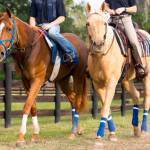Understanding Athletic Injuries to Improve Equine Safety, Welfare

Preventing musculoskeletal failures in equine athletes benefits all sport horses but requires data collection to identify specific injuries. Mitigating musculoskeletal injuries is vital to supporting these athletes and their careers.
To improve racehorse safety, a team of Australian veterinarians interviewed nearly 70% of trainers at the major tracks in Brisbane to collect data on injuries their horses sustained during racing and training.* Data was collected over a 13-month period. Compared to similar studies, a low incidence of musculoskeletal injuries was noted, with 0.56% of all horses sustaining an injury each week.
“This low incidence of injuries was thought to be partly due to the close veterinary involvement in racehorse management. This provided trainers with easy access to diagnostic equipment, which plays an important role in monitoring horses and preventing musculoskeletal injuries,” relayed Peter Huntington, B.V.Sc., M.A.C.V.Sc., director of nutrition at Kentucky Equine Research.
The data on musculoskeletal injuries also revealed the specific types of injuries that occurred. Differences in those injuries between younger and older horses were also identified. Researchers found:
- Two-year-olds had a higher incidence of musculoskeletal injuries than older horses;
- Younger horses were commonly diagnosed with dorsal metacarpal disease or shin soreness, which is pain localized in the front of fore cannon bones;
- Older horses more commonly suffered inflammation of the suspensory ligament, superficial digital flexor tendinitis, fractured proximal sesamoid bones, and other fetlock injuries; and
- Even though the overall incidence of musculoskeletal injuries was low, when they did occur the outcome could be severe.
“The higher rate of injuries in young horses found in this study mirrors previously published data. Young horses must undergo gradual increases in high-speed exercise and training intensity with limited time galloping or breezing to allow tissues to adapt appropriately to prevent musculoskeletal injuries,” said Huntington.
According to the study, dorsal metacarpal disease is sometimes “considered a normal part of the process of training two-year-old horses and has an excellent prognosis for full recovery.”
When experienced trainers recognize dorsal metacarpal discomfort, they should alter their conditioning programs to prevent disease progression while promoting the bone adaptation required for racing.
“Kentucky Equine Research demonstrated that dorsal metacarpal disease is associated with failure to maintain the increase in bone mineral density that normally occurs during training of yearlings and two-year-olds. More recent work has shown that the nutritional supplement Triacton leads to significant increases in bone density of two- and three-year-old racehorses in training compared to a control group fed a placebo,” Huntington relayed.
*Crawford, K.L., A. Finnane, R.M. Greer, C.J.C. Phillips, S.M. Woldeyohannes, N.R. Perkins, and B.J. Ahren. 2020. Appraising the welfare of Thoroughbred racehorses in training in Queensland, Australia: The incidence and type of musculoskeletal injuries vary between two-year-old and older Thoroughbred racehorses. Animals (Basel) 10(11):2046.








